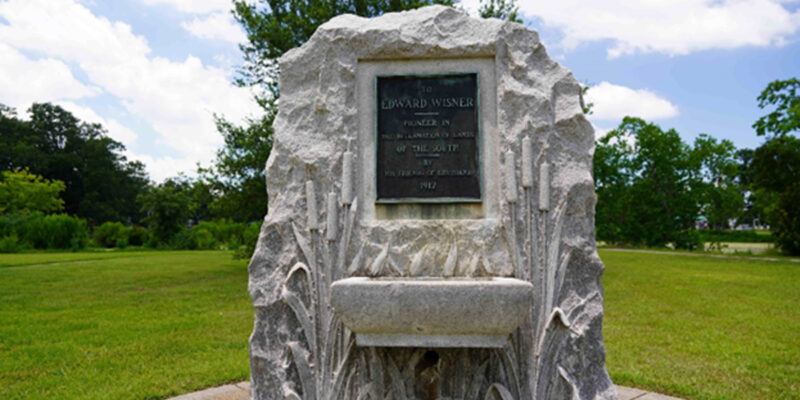The Wisner Family won in the Appeals Court on June 8, 2023 against the City Council of New Orleans. The City Council of New Orleans should be grateful to the Wisner Family and be thanking them for their hundreds of millions in philanthropy benefitting New Orleans over the last century, rather than suing the family for more revenue and all assets of the Trust as they’re doing.
Mayor Cantrell inherited numerous problems from Mitch Landrieu. One of which was resolving the Wisner Trust. She resolved the trust in a positive manner that provides an ongoing stream of philanthropy to the City of New Orleans and deserves credit for having accomplished the task in a manner that is fair to all.
Edward Wisner Was born in 1860 in Michigan into a farming family and moved to northern Louisiana in 1888 as a farmer. The town of Wisner, located on Highway 425 between Sicily Island and Winnsboro, bears his name. Wisner is a very patriotic town and would have been grateful for being a beneficiary of the Wisner Trust.
In 1900, Wisner moved to New Orleans and began to reclaim land. Edward Wisner made his donation on August 4, 1914 of numerous acres of land in various parishes to the City of New Orleans, the Board of Administrators of Tulane University, the Board of Administrators of the Charity Hospital, and the Commander of the Salvation Army. The donation consisted of 1,840 acres in Jefferson Parish, 2,412 acres in St. John the Baptist Parish, and 49,248 acres in LaFourche Parish. Edward Wisner died in 1915 leaving a widow in community and two daughters, Rowena and Elizabeth.
In 1928, the Wisner ladies brought suit against the four benefactors of the donation because it was made without Mary Wisner’s consent. A settlement was reached in which: 1) the Wisner Ladies ratified and acknowledged the validity of the 1914 donation and trust; 2) the four original trust beneficiaries recognized the Wisner Ladies, collectively, as an additional beneficiary with a 40% interest in the trust, (the City—34.8%, Tulane and Charity—12% each, and Salvation Army–1.2%); 3) the parties agreed to hold the property in indivision, foregoing their rights to segregation; and 4) the City Council was to create an Advisory Committee known as the “Edward Wisner Donation Advisory Commission,” which would be comprised of five members: the Mayor as chair, and four representatives from each of the beneficiaries.
For a century this worked well, with New Orleans non-profits receiving over $1.5 million in donations from the Wisner Trust in 2014. For years, the average annual grant was approximately $17,000.00. Many non-profits received $5,000.00 or $10,000.00 with the New Orleans Philharmonic and other major non-profits receiving $50,000.00 to $75,000.00 annually. An annual event was held to publicize the Wisner Grant and its recipients. Across New Orleans, a message thanking the Wisner Trust appears on many pieces of outdoor art.
By 2015, Mitch Landrieu needed money to remove the monuments. Landrieu set up a system to fund the removal of the art. During this time, Landrieu stopped the annual public Wisner event and awards became private and long-time grantees were suspended from receiving grants.
Between 2015 to 2018, Landrieu transferred over $1,000,000.00 to the Foundation for Louisiana. Landrieu also obtained funds for the Foundation for Louisiana to do community development work in the Treme under the Claiborne Ave overpass. The Foundation for Louisiana paid Cuzan, LLC, which was the only bidder on the project at $600,000.00 to remove the monuments.
Since Cuzan, LLC did not have the needed equipment, another $400,000.00 was paid for used cranes. The cranes sat at the City Vehicle Repair Yard for months after the removal of the monuments. It appears Cuzan hired firemen to remove the monuments.
Advertisement
Chapters 17 to 20 of the book, “Monumental Heist: A Story of Race; A Race to the White House” provide images and spreadsheets of Wisner funds and cranes.
Link to Monumental Heist website: www.MonumentalHeist.com
Later Landrieu granted over $2,000,000.00 to the New Orleans 2018 Foundation. Over $1,000,000.00 of those funds were used for Tricentennial Parties Landrieu held at Gallier Hall during his final days in office, May 4th to May 8th, 2018. The parties were for national and international mayors.
The League of Women Voters had suggested in 2012 to Landrieu to move the Mayor’s inauguration date from May to January following City Council and Mayoral elections in November, but Landrieu declined. This allowed him to host the Tricentennial parties, and delayed Mayor Cantrell from taking office till just before Hurricane Season, creating another problem for Mayor Cantrell to solve.
Ten days after Cantrell took office, On May 18, 2018, New Orleans would experience an intense flood. Landrieu’s head of Sewage & Water Board resigned from office after the city flooded in August 2017. The city had over a dozen boil water advisories during Landrieu’s terms as mayor.
The solution isn’t for the City Council to sue to take of the whole Wisner Trust, rather the solution is to return the Wisner Trust into its original purpose, of letting the advisory board determine grant recipients and host an annual awards event in which the mayor hands out the checks. One worthy recipient would be a project to honor the Wisner Family.
West End Lakeshore Park was established in 1906 and is an example of reclaimed land. A monument to Edward Wisner is located at the East End. The Historic Darlington Fountain was dedicated in Wisner’s honor in 1916. In a recent survey on West End Lakeshore Park 97% of the respondents favored for city to include West End Lakeshore Park in annual Wisner allotments. One concept is to rename West End Lakeshore Park as Wisner West End Lakeshore Park.
Link to Survey: https://www.surveymonkey.com/r/3Q8ZDKS?fbclid=IwAR12JaoJxDH_9BsksNxGidzRlSCorncLLEut0huF-k3f-iHId4H02NqkggA
Advertisement
Advertisement

